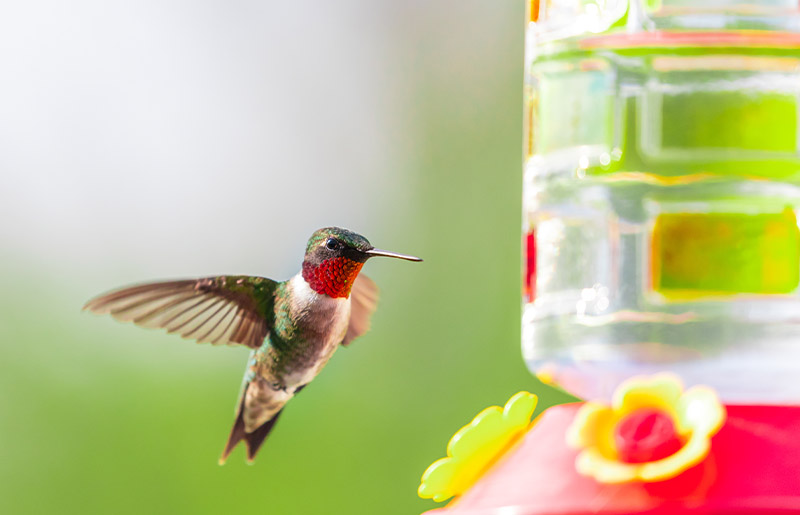
Easy DIY Hummingbird Nectar for Migrating Hummingbirds
Hummingbirds have been spotted across the Greater Houston Area for a few weeks as they make their way south for the winter. Although several species will continue their trek down to Mexico or Central America for the winter, many can be seen around Houston through the winter, like Rufous, Black-chinned, Allen's, Anna's, Broad-tailed, and Buff-bellied hummingbirds.
Ever wonder why it can be difficult to observe a hummingbird in flight? According to the National Audubon Society, hummingbirds flap their wings faster than any other bird at up to 70 wingbeats per second. That adds up to more than 4,000 wingbeats per minute! Due to their wing speed and relatively small body size, they fly as fast as 30 miles per hour on average, but can fly even faster in certain circumstances. So if they move so fast, how can we catch a glimpse of their beautiful feathers and observe their astonishingly fast body movements?
Install a hummingbird feeder at home!
According to the Houston Audubon, hummingbirds live on a combination of flower, nectar and minute insects. Often they eat insects found in the nectar, and they also catch insects in the air. In winter, hummingbirds are known to follow sapsuckers around to feed on tree sap extracted from sapsucker drilling holes.
Feeders are a very useful supplement to the hummingbird's natural foods. There are several excellent brands on the market - just be sure to use one that can be easily cleaned. Every few days, feeders need to be cleaned every few days since our humid weather promotes sooty mold growth on feeder parts and is harmful to hummingbirds. Since only one bird will feed at a feeder at a time, the feeder does not need to be large. Some feeders come supplied with bee guards, which are small plastic plugs with a grid design. Studies have shown that bee guards have sometimes caused injury to hummingbird bills, so the Houston Audubon does not recommend their use. If the design of the feeder is such that a bee guard is required, cut out the center of the guard with wire clippers to avoid possible injury.
Once you have purchased or made your own DIY hummingbird feeder, step into the kitchen to make this easy homemade hummingbird nectar for our feathered friends, plus some hepful tips to ensure the success of your feeder by the Houston Audubon.
Homemade Hummingbird Nectar
Do Not Use Red Food Coloring! As long as there is some red on the feeder, the hummingbirds will find it. It is not necessary to buy commercial hummer nectar, as it is very easy to make. Simply mix hot water and sugar. Us no sweetener except sugar (no honey and no artificial sweetener!).
Feeder Placement
Hummingbirds will more readily use a feeder if it is close to hummer-attracting plants. Try to put it in an area which receives some shade. In particular, glass feeders should not be placed where they will get afternoon sun as in the summer the nectar temperature would become unbearably hot. Hummingbirds appreciate having a nearby shrub or tree to perch in. They are very aggressive about protecting a feeder. Therefore if you want to provide nectar for several hummingbirds, try to place several small feeders in widely separated areas rather than using one large feeder.
It is not necessary to take down your feeder in the winter, since there are always some birds who stay here in the winter months. But if you choose to keep it up past October, you must be particularly careful to keep it filled as birds will rely on it more than in other times of the year. Hummingbirds are able to survive extremely cold temperatures if their food source is maintained. Hummingbirds survived the Christmas freeze of 1989 when temperatures dropped to 8 degrees, but the feeders needed to be replaced every couple of hours to keep the nectar from freezing. Brooder lights have been used quite successfully to keep feeders from freezing during prolonged cold spells, even with temperatures in the teens. Under normal Houston winter conditions it is only necessary to bring the feeder indoors on nights when a freeze is predicted. But remember to put it back out first thing in the morning!


